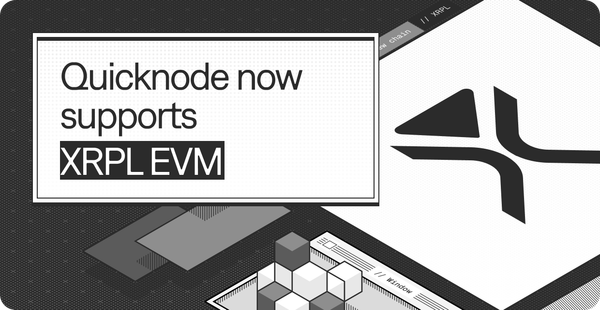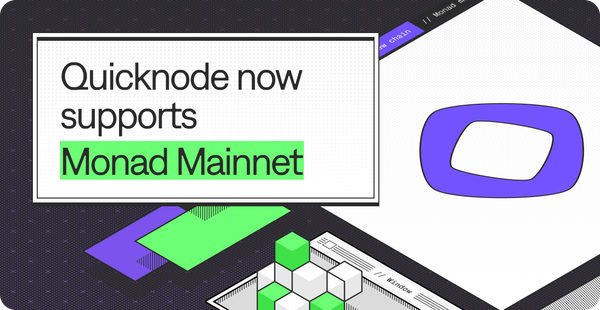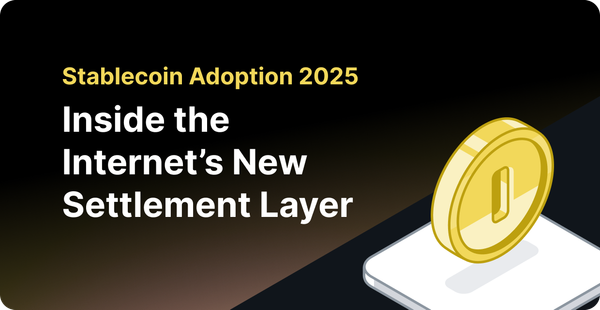Web3 development: EVM Compatible Blockchains 101
Explore how blockchain technology is transforming the financial sector, from peer-to-peer lending to decentralized trading.

Fragmentation in web3 is a major obstacle in its development and mass adoption. Multiple blockchain networks, each with its protocols, standards, and ecosystems have truly hurt the potential of web3.
It has led to siloed development environments and developers have to choose between pursuing interoperability — making blockchains talk to each other — or building the same protocol or dApps on various blockchains.
Both approaches require immense time and resources, which means developers are fighting a losing battle regardless of whichever path they choose.
Enter Ethereum virtual machine (EVM) — a solution to web3's fragmentation. EVM offers a standardized development environment across different EVM-compatible blockchains.
Now, what exactly is EVM and how does it work?
In this blog, we will help you understand EVM and its working. Most importantly, what is EVM-compatibility, and which blockchains are EVM-compatible?
What is EVM — Ethereum virtual machine?
EVM, as the name suggests, is a simulated computing environment that provides the functionality of Ethereum's blockchain. It allows developers to write smart contracts in high-level programming languages like Solidity. The high-level code is compiled into bytecode, a lower-level, machine-readable format, making Ethereum smart contracts highly portable.
This setup ensures that the same piece of code behaves identically on any Ethereum node, maintaining consistency across the network. Further, this consistency simplifies the development process, adds security, and bootstraps cross-chain compatibility.
Features of Ethereum virtual machine (EVM)
Here are three key features that make EVM a crucial component of web3 development:
- Turing-completeness: The EVM is Turing-complete, meaning any node on the network can execute smart contracts or compute transactions.
- Consensus-agnosticism: The EVM's computation is independent of the consensus mechanism of the network.
For instance, EVM didn’t change when Ethereum transitioned from proof of work (PoW) to proof of stake (PoS).
- Opcode: Opcodes are fundamental to the operation of the EVM. They make up the bytecode and dictate the operations that the EVM must perform.
How does the Ethereum virtual machine (EVM) work?
Here's an outline of how the EVM works:
Solidity > Bytecode > Opcode
The translation of code from Solidity to bytecode to opcode is the focal point of EVM functioning. It bridges the code that developers write and the code that EVM understands and acts upon.
Developers use Solidity to write the logic of smart contracts in a syntax that is somewhat similar to JavaScript — making onboarding easier for web2 developers. The Solidity code is then compiled into bytecode — a low-level, machine-readable format that the EVM can understand and execute transactions — and is deployed on Ethereum.
Then, the EVM reads the bytecode and breaks it down into a series of opcodes, short for operation code. Each opcode is a specific instruction that tells the EVM what operation to perform, be it transferring Ether or calling a smart contract function.
Deterministic execution
The EVM’s opcode execution is deterministic, meaning it produces the same result on any EVM-compatible network. This consistency helps maintain consensus and integrity across these platforms and ensures that smart contracts behave predictably and reliably.
As a result, users and developers alike can trust that the dApp will function exactly as expected. Reliability of this level is a must for financial transactions, especially those that are high-value and automated.
To sum up, deterministic execution helps in maintaining consensus, ensuring security, and building user trust in the EVM.
Gas
Each operation in the EVM consumes a certain amount of gas which acts as a remuneration to the nodes and the network for facilitating the transaction. They also act as a security mechanism and prevent bad actors from spamming the network.
For developers, the aim is always to write efficient and optimized code to reduce transaction fees which attracts users. Conveniently EVM chains do have a sufficiently predictable execution cost, meaning developers can estimate the gas required for their transactions and smart contract executions.
In short, the gas system is key to the health and security of the EVM.
Isolation
Since a lot of networks work using the EVM, the number of attack vectors is super high. Even a single vulnerability or security risk can cause a systemic collapse.
To avoid this, EVM works in a sandbox isolating every smart contract and its execution from the rest of the network. This facet comes across as a solution to the fluidity and expansiveness of EVM.
This maintains the network’s integrity and ensures that any smart contract error is confined to that specific contract preventing the risk of systemic failures. Similarly, isolation also helps maintain data integrity and privacy by minimizing the risk of unauthorized data access or manipulation.
All in all, these security and privacy barriers make developers more confident about building on EVM chains.
State transition
The state transition function of the EVM ensures that all state changes — such as updating Ether (ETH) balances in user accounts after a transaction — are consistently updated and broadcast to all the nodes in the network.
By strictly defining state transition, EVM ensures that the blockchain remains the single source of truth and mitigates the risk of fraudulent updates and transactions.
This function of EVM aids developers a lot by making Ethereum more predictable and reliable. However, diving deeper, features like multi-step transactions, token creation, and automated contract execution rely on state transitions. Hence, it is a key element of web3 development.
Now, we have understood how the EVM works. In the next section, we will see how EVM is employed to achieve compatibility with other blockchains.
EVM compatibility explained
EVM compatibility refers to the ability of smart contracts written for Ethereum to run on other blockchains without any major change. This compatibility is achieved by blockchains implementing Ethereum's opcode specifications and state transition rules.
EVM’s innate feature of interoperability makes for a uniform development environment, streamlining dApp development, testing, and launch. It expands the reach of dApps and protocols, allowing them to tap into different networks' user bases and resources while leveraging Ethereum's mature ecosystem and tooling.
Benefits of EVM-compatible blockchains
EVM (Ethereum virtual machine) compatible blockchains help developers in the following ways:
- Simplified development: Developers can write smart contracts using familiar tools and languages like Solidity, reducing the learning curve.
- Portability: EVM compatibility enables the portability of smart contracts and dapps to other compatible blockchains. Code once and deploy it multiple times is the mantra.
- User base: EVM-compatible blockchains have access to a huge user base. Since these chains can run Ethereum-based dapps, they can also attract native Ethereum users.
- Interoperability: EVM-compatible blockchains can interact and exchange information and value with other compatible blockchains.
- Tooling and resources: Developers and users can use Ethereum's existing ecosystem, including wallets, oracles, developer tools, and smart contract libraries.
What is a zkEVM?
As the name suggests, zkEVM is the integration of zk i.e. zero-knowledge tech with EVM.
In essence, zkEVM uses zero-knowledge proofs (ZKPs), a cryptographic method that allows one party to prove to another that a statement is true, without revealing any more information. By integrating this into the EVM, zkEVM enables transactions and smart contract executions to be validated more efficiently and privately.
Benefits of zkEVM over traditional EVMs
1. Reduces computational burden
zkEVM reduces the computational burden on the network as it uses ZKPs that attest to the correctness of these transactions. This saves time and resources that would have been spent by traditional EVMs to execute all operations and validate their outcomes.
2. Enhances privacy
Private data and blockchain transparency don’t always go hand-in-hand. ZKPs, however, execute transactions without revealing the data, maintaining privacy, and securing user data.
3. Improves scalability & throughput
zkEVM aggregates multiple transactions into a single batch and generates a ZK proof to authenticate them. This increases the number of transactions that can be processed within a block, enhancing the overall throughput of the network.
What are zero-knowledge proofs?
Zero-knowledge proofs or ZKPs allow one party (the prover) to prove to another party (the verifier) that a certain statement is true, without revealing any further information about the statement.
Scalability and privacy are two areas where ZKPs are expected to improve the status quo of blockchain and web3.
ZKPs for scalability
ZKPs are the fulcrum around which zk-rollups, a major layer 2 scaling solution, revolve around. ZK-rollups aggregate multiple transactions into a single transaction and employ ZKPs to attest to the validity of all transactions in the bundle.
This way, the network saves a lot of computation efforts and resources traditionally needed to process the transactions. Thereby, ZKPs increase transaction throughput and reduce network congestion.
ZKPs for privacy
ZKPs ensure that sensitive information remains confidential by verifying transactions without revealing any underlying data.
Ex: A user can prove they have enough funds for a transaction without revealing their total balance, or verify their age without disclosing their exact birth date.
ZKPs achieve this level of privacy without compromising the security and integrity of the blockchain. This makes ZKP-based solutions more friendly and welcoming for institutions and big players prioritizing privacy and security.
Popular EVM-compatible blockchains
Here are the top 5 EVM-compatible blockchains:
- Polygon is a multi-faceted Ethereum scaling and infra platform. Polygon facilitates horizontal scalability by helping build Ethereum-compatible chains and interconnecting them. They are also amping up zkEVM efforts using both ZK and optimistic rollups.
- Binance Smart Chain (BSC) is a high-performance blockchain with EVM compatibility. It is primarily designed for decentralized trading and efficient smart contract execution.
- Arbitrum is a layer 2 scaling solution. It employs optimistic rollups to enhance Ethereum’s throughput while reducing costs.
- Avalanche is a highly scalable blockchain running on Avalanche consensus protocol that offers near-instant transaction finality. It also supports interoperable subnets i.e. application-specific blockchains that can interact while being EVM-compatible.
- Optimism is a layer 2 scaling solution that uses optimistic rollups i.e. transactions are considered valid by default with a provision for challenging. This way, Optimism can process more transactions with faster finality, reducing Ethereum congestion.
EVM-Compatibility: the bedrock for web3’s mass adoption?
Fostering a unified and efficient web3 is the key to Ethereum being a solution for the masses and not limited to the tech-savvy only. And EVM-compatibility is a fundamental driver in this pursuit. The interoperability accelerates innovation and brings all users on the same and leveled playing field, improving web3 accessibility.
EVM compatibility significantly makes lives easier for developers. They can code and build dapps once and easily deploy them across all the compatible blockchains. This portability saves time and resources, as there's no need to rewrite contracts for different networks. The familiarity with tooling, testing, and resources also reduces the learning curve for developers.
Looking ahead, EVM compatibility is set to become even more integral to web3. It also has the potential to bridge traditional tech with web3, offering a smooth onboarding process.
Want to build your own chain?
Fill out a simple form to experience the advantages of QuickNode’s AppChain and RaaS solutions. Our team will work with you to meet your specific needs and ensure you receive the most relevant tools and support.
For additional resources and insights into our cutting-edge AppChain and RaaS solutions, explore the following:
- Appchain & Rollup-as-a-Service
- Video: What are Appchains and Rollup-as-a-Service (RaaS)
- QuickNode’s Deep-Dive Into Appchains and Rollups-as-a-Service (RaaS)
QuickNode: Accelerating AppChain and Rollup Adoption
While appchains and RaaS solutions are theoretically ideal for developers, the complexities involved during practical implementation often prove challenging without robust support and credible resources.
QuickNode's AppChains and RaaS offerings represent a significant step in the right direction, aiming to simplify web3 development for developers while granting them control and flexibility. The adaptability of these solutions, coupled with QuickNode's well-established infrastructure, ensures a smooth and reliable development experience.
Ultimately, a superior developer experience invariably translates into high-performance applications and innovative use cases, as developers can now focus their efforts on core application functionality rather than building it from scratch.

About QuickNode
QuickNode is building infrastructure to support the future of Web3. Since 2017, we've worked with hundreds of developers and companies, helping scale dApps and providing high-performance access to 25+ blockchains. Subscribe to our newsletter for more content like this, and stay in the loop with what's happening in Web3!





